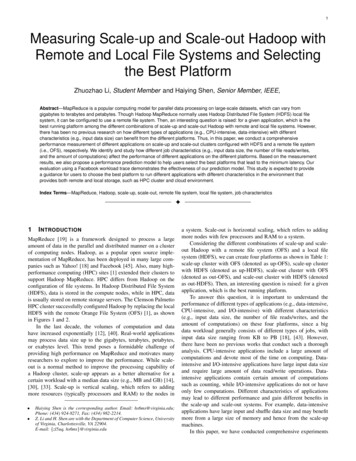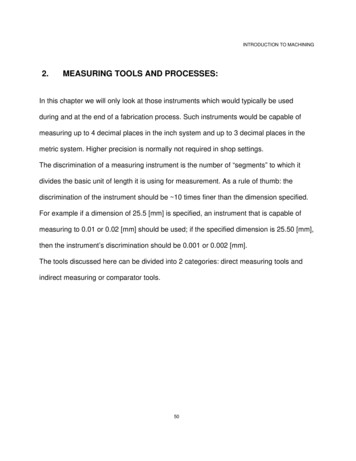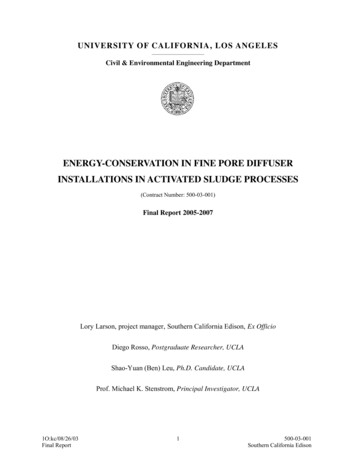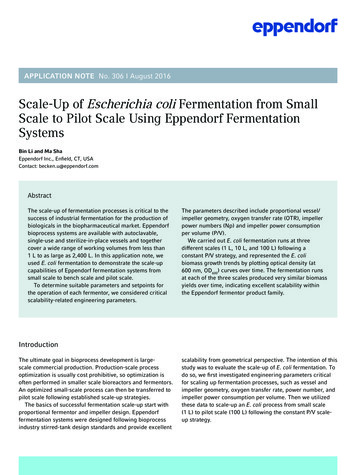
Transcription
1Measuring Scale-up and Scale-out Hadoop withRemote and Local File Systems and Selectingthe Best PlatformZhuozhao Li, Student Member and Haiying Shen, Senior Member, IEEE,Abstract—MapReduce is a popular computing model for parallel data processing on large-scale datasets, which can vary fromgigabytes to terabytes and petabytes. Though Hadoop MapReduce normally uses Hadoop Distributed File System (HDFS) local filesystem, it can be configured to use a remote file system. Then, an interesting question is raised: for a given application, which is thebest running platform among the different combinations of scale-up and scale-out Hadoop with remote and local file systems. However,there has been no previous research on how different types of applications (e.g., CPU-intensive, data-intensive) with differentcharacteristics (e.g., input data size) can benefit from the different platforms. Thus, in this paper, we conduct a comprehensiveperformance measurement of different applications on scale-up and scale-out clusters configured with HDFS and a remote file system(i.e., OFS), respectively. We identify and study how different job characteristics (e.g., input data size, the number of file reads/writes,and the amount of computations) affect the performance of different applications on the different platforms. Based on the measurementresults, we also propose a performance prediction model to help users select the best platforms that lead to the minimum latency. Ourevaluation using a Facebook workload trace demonstrates the effectiveness of our prediction model. This study is expected to providea guidance for users to choose the best platform to run different applications with different characteristics in the environment thatprovides both remote and local storage, such as HPC cluster and cloud environment.Index Terms—MapReduce, Hadoop, scale-up, scale-out, remote file system, local file system, job characteristicsF1I NTRODUCTIONMapReduce [19] is a framework designed to process a largeamount of data in the parallel and distributed manner on a clusterof computing nodes. Hadoop, as a popular open source implementation of MapReduce, has been deployed in many large companies such as Yahoo! [18] and Facebook [45]. Also, many highperformance computing (HPC) sites [1] extended their clusters tosupport Hadoop MapReduce. HPC differs from Hadoop on theconfiguration of file systems. In Hadoop Distributed File System(HDFS), data is stored in the compute nodes, while in HPC, datais usually stored on remote storage servers. The Clemson PalmettoHPC cluster successfully configured Hadoop by replacing the localHDFS with the remote Orange File System (OFS) [1], as shownin Figures 1 and 2.In the last decade, the volumes of computation and datahave increased exponentially [12], [40]. Real-world applicationsmay process data size up to the gigabytes, terabytes, petabytes,or exabytes level. This trend poses a formidable challenge ofproviding high performance on MapReduce and motivates manyresearchers to explore to improve the performance. While scaleout is a normal method to improve the processing capability ofa Hadoop cluster, scale-up appears as a better alternative for acertain workload with a median data size (e.g., MB and GB) [14],[30], [33]. Scale-up is vertical scaling, which refers to addingmore resources (typically processors and RAM) to the nodes in Haiying Shen is the corresponding author. Email: hs6ms@virginia.edu;Phone: (434) 924-8271, Fax: (434) 982-2214.Z. Li and H. Shen are with the Department of Computer Science, Universityof Virginia, Charlottesville, VA 22904.E-mail: {zl5uq, hs6ms}@virginia.edua system. Scale-out is horizontal scaling, which refers to addingmore nodes with few processors and RAM to a system.Considering the different combinations of scale-up and scaleout Hadoop with a remote file system (OFS) and a local filesystem (HDFS), we can create four platforms as shown in Table 1:scale-up cluster with OFS (denoted as up-OFS), scale-up clusterwith HDFS (denoted as up-HDFS), scale-out cluster with OFS(denoted as out-OFS), and scale-out cluster with HDFS (denotedas out-HDFS). Then, an interesting question is raised: for a givenapplication, which is the best running platform.To answer this question, it is important to understand theperformance of different types of applications (e.g., data-intensive,CPU-intensive, and I/O-intensive) with different characteristics(e.g., input data size, the number of file reads/writes, and theamount of computations) on these four platforms, since a bigdata workload generally consists of different types of jobs, withinput data size ranging from KB to PB [18], [43]. However,there have been no previous works that conduct such a thoroughanalysis. CPU-intensive applications include a large amount ofcomputations and devote most of the time on computing. Dataintensive and I/O-intensive applications have large input data sizeand require large amount of data read/write operations. Dataintensive applications contain certain amount of computationssuch as counting, while I/O-intensive applications do not or haveonly few computations. Different characteristics of applicationsmay lead to different performance and gain different benefits inthe scale-up and scale-out systems. For example, data-intensiveapplications have large input and shuffle data size and may benefitmore from a large size of memory and hence from the scale-upmachines.In this paper, we have conducted comprehensive experiments
File System Test duceHadoopMapReduceHadoopMapReduceHadoopMapReduce OrangeFS Fig. 1. Typical Hadoop with HDFS local storage (HDFS in short).TABLE 1Different platforms.Scale-upScale-outOFSup-OFSout-OFSHDFS up-HDFS out-HDFSfor different types of applications (including data-intensive, CPUintensive, and I/O-intensive applications) on the four platformswith different input data sizes and provide an insightful analysis ontheir performance. We also have analyzed how different application characteristics affect the application performance and systemoverheads on the four platforms and determine the best platformfor an application with certain characteristics. Our measurementresults provide a guidance on how to select the best platform torun different types of applications with different characteristics.The contributions of our paper are as follows:1. We have conducted thorough experiments for different typesof applications (including data-intensive, CPU-intensive and I/Ointensive) on the four platforms. We have analyzed how different application features (e.g., input data size, the number ofreading/writing files and the amount of computations) affect theapplication performance on the four platforms and determine thebest platform for an application with certain features. We confirmthat replacing HDFS with OFS for Hadoop is feasible when datasize is relatively large.2. Our measurement results provide a guidance on how to selectthe best platform that leads to minimum latency to run differenttype of jobs with different job characteristics.3. Based on the measurement results, we also propose a performance prediction model to help users select the best platforms.Our evaluation using a Facebook workload trace demonstrates theeffectiveness of our prediction model.The remainder of this paper is organized as follows. Section 2describes the configurations of scale-up and scale-out machines forHadoop with OFS and HDFS on a HPC-based cluster. Section 3presents the measurement results of performance for differenttypes of Hadoop applications and provides an in-depth analysisof the results. Section 4 summarizes the observations and furtherdiscusses the guidance to cloud environment. Section 5 presentsa performance prediction model to help users select the bestplatforms and evaluates the prediction accuracy of our predictionmodel. Section 6 gives an overview of the related work. Section 7concludes this paper with remarks on our future work.22Remote Client Test ConfigurationC ONFIGURATIONS ON HPC-BASED H ADOOPIn this section, we introduce the details on how to configureHadoop MapReduce on a HPC cluster. We do our experimentson HPC cluster because HPC clusters generally have machineswith different CPU and memory, which allows us to deploy scaleup and scale-out machines easily without any further cost. Inour experimental measurement, we use Clemson Palmetto HPCcluster, which ranks the top five fastest supercomputers at publicuniversities in United States and the 66th fastest supercomputersglobally [5].Fig. 2. Hadoop with the OrangeFS remote storage (OFS in short).2.1Introduction of Hadoop MapReduceMapReduce [19] is a scalable and parallel processing frameworkto handle large datasets. HDFS is a highly fault tolerant andself-healing distributed file system to cooperate with HadoopMapReduce. HDFS has a master/slave architecture, which generally consists of a namenode and multiple datanodes. Namenodemanages the metadata of the cluster and provides the access tofiles to clients, while datanodes are used to store the data blocks.HDFS stores the input data of each job into several blocks. Thedata sizenumber of blocks is calculated by inputblock size . In a MapReducejob, there are generally three phases: map, shuffle and reduce. Inthe map phase, the job tracker assigns each mapper to process onedata block. Note that the data block may locate at the same nodeswith the mapper, which is called data locality. Hadoop MapReduceprefers high data locality to reduce network consumption for datamovement to improve performance. All the mappers generatethe output, called intermediate data (i.e., shuffle data). In theshuffle phase, each mapper’s output is then partitioned and sorted.Different partitions are shuffled to corresponding reducers. Oncethe reducers are scheduled on specific nodes by the job tracker,the shuffle data is copied to the reduce nodes’ memory first. If theshuffle data size is larger than the size of in-memory buffer, theshuffle data will be spilled to local disks, which results in extraoverheads. In the reduce phase, the reducers aggregate the shuffledata and produce the final output of the jobs.2.2Experiment EnvironmentIn the experiments, we use the Hadoop MapReduce version1.2.1. We use four machines for scale-up Hadoop. Each scaleup machine is equipped with four 6-core 2.66GHZ Intel Xeon7542 processors, 505GB RAM, and 91GB hard disk and 10GbpsMyrinet interconnections. To achieve fair performance comparison, we require the scale-up and scale-out machines have similarcost. We investigated the cost information from [9] and foundthat one scale-up machine matches similar price with 6 scaleout machines. Therefore, the scale-out cluster consists of twentyfour machines, each of which has two 4-core 2.3GHZ AMDOpteron 2356 processors, 16GB RAM, and 193GB hard disk and10Gbps Myrinet interconnections. Note that Myrinet is a highspeed local area networking system. It has much lower protocoloverheads than Ethernet and hence can provide better throughput.With Myrinet, the data can be accessed with less latency and thecommunication overheads between each node are reduced.2.3Configurations on HDFS and OFSAs we mentioned in Section 1, while traditional Hadoop isdeployed with the distributed local file system HDFS, conventionalHPC architecture relies on the remote file system. On HPC cluster,compute and data are separated and connected with high speedinterconnects, such as Ethernet and Myrinet. However, we canstill deploy Hadoop MapReduce framework with HDFS on HPCcluster. Under the help of myHadoop [28], we easily configureHadoop with HDFS on the HPC cluster in our university.
3Recently, in order to achieve better performance, a Java NativeInterface (JNI) shim layer has been successfully implemented onthe HPC cluster in our university, which allows Hadoop to workdirectly with remote file system OFS. Both the input and outputdata can be stored in the remote file system, while the shuffle datais still required to store in local file system of each node. OFS isa parallel file system (PVFS) that distributes data across multipleservers. Moreover, OFS is demonstrated to be able to offer muchbetter I/O performance [1] than HDFS on processing large amountof data.In order to achieve fair comparisons between the remote filesystem and the local file system, a couple of parameters arerequired to be set consistently in OFS and HDFS. In HDFS, we setthe HDFS block size to 128MB to match the setting in the currentindustry clusters [45]. Similarly, OFS stores data in simple stripes(i.e., similar as blocks in HDFS) across multiple storage servers inorder to facilitate parallel access. In order to compare OFS fairlywith HDFS, we also set the stripe size to 128MB. Typically, in current commercial MapReduce cluster [14], the total number of mapand reduce slots is set to the number of cores. Therefore, in ourexperiments, each scale-up machine has 24 map and reduce slots,while each scale-out machine has 8 map and reduce slots in total.For HDFS, the replication factor is set to 3 by default, whichmeans that each file block has three replicas. For OFS, it currentlydoes not support build-in replications. However, it does not affectour measurement results since data loss never occurs in OFSduring our experiments.2.4Configurations for Best PerformanceThe scale-out architecture deploys many scale-out machines withless powerful CPU and small RAM size. On the other hand, thescale-up architecture has a few machines with high performanceCPU and large RAM size. In order to fully utilize the CPU andRAM size advantages of scale-up machines, several parameters ofthe scale-up Hadoop clusters are configured differently from theconventional Hadoop clusters.Heap size In Hadoop, each map and reduce task runs in a JVM.The heap size is the memory allocated to each JVM for bufferingdata. The map outputs are written to a circular buffer in memory,which is determined by the heap size [14]. When the circularbuffer is closed to full, the data is spilled to the local disk, whichintroduces overheads. Therefore, by increasing the heap size, it isless likely for the data to be spilled to local disk if the heap size islarger, leading to better performance in the shuffle phase.The heap size is 200MB for each JVM by default in Hadoop.In the experiments, the machines for scale-up and scale-out machines allow us to set the heap size to a much larger value than200MB. We tune the heap size through trial and error on bothscale-up and scale-out machines. To achieve the best performanceand also avoid the out of memory error [14], we set the heap sizeto 8GB per task on scale-up machines, and to 1.5GB on scale-outmachines, respectively, through trial and error.RAM drive to place shuffle data After setting the heap sizeto 8GB, we find that there is still much memory left (more than300GB) on scale-up machines. In Hadoop, the shuffle data of thejobs is required to store on local file system. On the HPC clusterin our university, it enables us to use half of the total memory sizeas tmpfs, which serves the same functions as RAMdisk. Therefore,we use half of the RAM (253GB) as RAMdisk to place the shuffledata on scale-up machines. If the shuffle data size is larger thanthe available RAMdisk size, the rest of the shuffle data is storedReduce taskMapOutputShuffleReduceInputblockMap taskReduce taskInputblockMap taskReduce taskInputblockMap taskReduce taskMap stageReduce stageFig. 3. Map, shuffle and reduce phases in MapReduce [19].Map phase durationStep 1Step 1Step 2Map taskStep 2 Step 1Step 2Reduce phase durationStep 3Shuffle phase durationStep 4Step 5Step 4Step 5 Reduce taskStep 4Step 5Job execution timeFig. 4. Timeline of each step in a MapReduce job.on the local disks. On the other hand, since the memory size isnot large on the scale-out machines (i.e., 16GB), the shuffle datais placed on the local disks only.Other configurations Besides the key configurations above,there are also some other Hadoop configuration parameters (e.g.,io.sort.mb and io.sort.spill.percent) that have significantly impacton the performance of the applications. To select the best platformsfor applications, we need to compare the best performance ofeach platform in the measurement study. Hence, we assume thatusers can leverage the tools in several previous studies suchas Starfish [22] and iTuned [20], which help configure Hadoopclusters to achieve the best performance for different applicationson different platforms. In the measurement study in Section 3, foreach application, we tune the Hadoop configuration parameters ondifferent platforms to achieve the best performance, based on theinstructions in Starfish [22]. As a result, we can focus on howjob characteristics of the applications affect the performance ondifferent platforms.Next, let us discuss the details in a Hadoop MapReduce job.Generally, a MapReduce job consists of map stage and reducestage, as shown in Figure 3. However, many researchers actuallyconsider that the MapReduce job has three phases by furthersplitting the reduce stage to shuffle phase and reduce phase. In thispaper, we consider that there are three phases in a MapReduce job– map phase, shuffle phase and reduce phase.2.5 g to [44], in the following, we break down the HadoopMapReduce execution flow and analyze the factors of each step ina job, as shown in Figure 4. Factors for the Time Duration of Map TaskStep 1. The map tasks of a job need to read the input data forthe MapReduce execution. The time duration of this data readingprocess depends on two main factors. The first one is the amountof input data that a map task needs to process. The second is theI/O speed of the file system.Step 2. Each map task processes one input data block andgenerates the intermediate key, value pairs (called map output
4data or shuffle data or reduce input data), according to the userdefined map function. The time duration of this step depends ontwo main factors. The first one is the amount of data each maptask needs to process. The second one is the speed of each nodeto process the data.For the second factor, as each node processes different jobs at adifferent speed, it is difficult to generalize a speed model for everyjob. However, since the map task’s function is to process the inputdata and generate intermediate data, we can approximately convertthe second factor to the map output data size, i.e., shuffle data size. Factors for the Time Duration of Shuffle TaskStep 3. In Hadoop, only when a certain portion (called mapcompletion threshold) of map tasks for a job have completed, thereduce tasks of this job are allowed to scheduled. Only after areduce task is scheduled, the shuffle task starts. The map outputsare first written to the memory buffer, and then spilled to thedisk. The map outputs are partitioned corresponding to the numberof reduce tasks. All the partitions are then transmitted to thecorresponding nodes that run the reduce tasks. The time durationof this step depends on three main factors. The first one is theamount of data each node needs to process. The second one isthe speed of the network to transmit the data. The third one is thebuffer size. Factors for the Time Duration of Reduce TaskStep 4. Note that the reduce tasks begin only after the shufflephase completes. Each reduce task takes the transmitted data fromthe shuffle phase and processes the shuffle data according to theuser-defined reduce function. As all the reduce tasks in the reducephase are run by the worker nodes in parallel, the time duration ofthis step depends on two main factors. The first one is the amountof data each reduce task needs to process. The second one is thespeed of each node to process the data. Similar to Step 2, we canactually convert the second factor to the generated output data size.Step 5. The output data of the reduce tasks is written to thefile system. The time duration of this step depends on two mainfactors. The first one is the amount of output data that a reducetask generates. The second one is the I/O speed of the file system.3P ERFORMANCE M EASUREMENTSIn this section, we will compare the performance of data-intensive,CPU-intensive, and I/O-intensive jobs with different input datasizes on the four platforms as mentioned previously. The fourconfigurations include scale-up machines with OrangeFS , scaleup machines with HDFS, scale-out machines with OrangeFS, andscale-out machines with HDFS, denoted by up-OFS, up-HDFS,out-OFS, and out-HDFS, respectively. We expect to provide aguidance for users on how different applications benefit fromdifferent platforms.3.1Measured Applications and MetricsWe classify the representative Hadoop benchmarks into threetypes: data-intensive, I/O-intensive and CPU-intensive in ourperformance measurement. We can roughly infer the types ofapplications by the size of the input data, shuffle data and outputdata. In general, data-intensive applications have large input andshuffle data sizes and devote much processing time to I/O requests,while I/O-intensive applications generally conduct only read/writeoperations on the file system. CPU-intensive applications includea large amount of computations such as iterative computations.The representative Hadoop applications we measure in this sectioninclude Wordcount, Grep, Terasort, table cross join [10], write andread test of TestDFSIO, PiEstimator, and matrix multiplication [4].Among them, Wordcount, Grep, Terasort and TCJ are typicaldata-intensive applications since they need to read/write and process a large amount of data. Wordcount and Grep have relativelylarge input and shuffle sizes but small output size, while Terasortgenerally has relatively large input, shuffle and output sizes. Wegenerated the input data for Wordcount, Grep, Terasort from abig data benchamrk BigDataBench [43], which is based on theWikipedia datasets.Table cross join (TCJ) is an application to cross join two tables.It is developed in Apache PIG, which is a high-level platformused with Hadoop. The application joins and sorts all the samekey-value pairs in two tables to a much larger table. The mapperscomplete most of the cross join jobs since the mappers need to listand sort out all the key-value pairs in the two tables. The reducersaggregate the same key-value pairs in the map output and generatethe final output.The write and read test of TestDFSIO are typical I/O-intensiveapplications. They complete a large number of read/write operations during the map tasks and only do some calculations likecalculating the I/O rate in the reduce tasks. In TestDFSIO, eachmapper reads/writes one file. It allows us to set the number ofmappers (i.e., the number of files) and the read/write size of file,regardless of the block size. For example, if we want to read/write80GB data in total, we can either read/write eighty 1GB filesor forty 2GB files, though the block size is 128MB. Note thatin Hadoop, the number of reading/writing files in a job actuallyaffects the number of disks the job reads/writes to, that is, thenumber of I/O operations on the cluster. More reading/writingfiles means more I/O operations and vice versa.The CPU-intensive applications we use in the experimentsare PiEstimator and matrix multiplication. PiEstimator uses astatistical (quasi-Monte Carlo) method [15] to estimate the valueof Pi. Points placed at random inside of a unit square also fallwithin a circle inscribed within that square with a probability equalto the area of the circle, Pi/4. The value of Pi can be estimatedfrom the value of 4R where R is the ratio of the number ofpoints that are inside the circle to the total number of points thatare within the square. The larger the sample of points used, thebetter the estimate is. The mappers generate a specified numberof sample points placed at random inside of a unit square andthen counts the number of those points that are inside a unitcircle. The reducers accumulate points counted by the mappers andthen estimates the value of Pi. Matrix multiplication (MM) in theexperiments calculates the multiplication of two square matrices.The two matrices are decomposed to a large number of smallblocks and hence each mapper processes one block multiplication,while the reducers aggregate all the output block results generatedin the mappers. The majority computations of the jobs are alsocompleted during the map phase.We measure these metrics for different applications: Execution time, which is the job running time and calculated bythe job ending time minus job starting time. Map phase duration, which is calculated by the last mapper’sending time minus the first mapper’s starting time. Shuffle phase duration, which is defined as last shuffle task’sending time minus the last mapper’s ending time. Reduce phase duration, which is from the ending time of the lastshuffle task to the end of the job.In the experiments, we normalize the execution time and mapphase duration by the results of up-OFS. For example, if a jobrunning on up-OFS and up-HDFS has an execution time of 10
2564480Input data size (GB)(c) Shuffle phase duration.(b) Map phase SInput data size (GB)Reduce phaseduration (s)Shuffle phaseduration (s)out‐OFSout‐HDFSout‐HDFS0.8(a) Execution time.80up‐OFS1Input data size lized mapphase 48Normalized executiontime1.8Input data size (GB)(d) Reduce phase duration.Fig. 5. Measurement results of data-intensive jobs of Wordcount.and 15 seconds, respectively, then up-OFS on the figure is shownas 1, while up-HDFS on the figure is shown as 1.5. Due to thelimit of local disk size, we cannot process data more than 80GBon up-HDFS platform. Therefore, in the following measurementresults, we do not show the up-HDFS for input data size more than80GB. On one hand, this limitation does not have any impactson our measurement analysis, as we are able to have meaningfulobservations before the input data size is increased to 80GB.On the other hand, we can take a first sight of the drawbackof scale-up machines from this limitation. That is, as the inputdata size increases, it finally exceeds the capability of scale-upmachines. Thus, scale-up machines are not as scalable as the scaleout machines. The number of map (reduce) waves of a job iscalculated by the number of distinct start times from all mappers(reducers) of the job. If the number of mappers (reducers) of a jobis larger than the number of map (reduce) slots in a node, partialmappers (reducers) are scheduled to all the slots first, forming thefirst wave. After the tasks complete and some slots are available,the second, third and subsequent waves are scheduled in sequence.When all the mappers (reducers) have the same execution time, thenumber o f tasksnumber of map (reduce) waves is equal to thethenumbero f task slots .3.2 Data-Intensive ApplicationsIn this section, we show the performance evaluation of dataintensive applications including Wordcount, Grep, Terasort, andTCJ. Figures 5(a), 6(a), 7(a), and 8(a) show the normalized execution time of Wordcount, Grep, Terasort, and TCJ versus differentinput data size, respectively. Note that in all these applications, thenumber of mappers is determined by the input data size, whichdata sizeis calculated by d InputBlock size e. Since the block size is fixed inthe experiments, the number of mappers is proportional to theinput data size. From the figures, we have several meaningfulobservations.We observe that when the input data size is small (WordCount:0.5-16GB, Grep and TeraSort: 0.5-8GB, TCJ: 1-16 mappers), theperformance of Wordcount, Grep, Terasort, and TCJ is better onthe scale-up machines than the scale-out machines. On the contrary, when the input data size is large (WordCount: 32GB, Grepand TeraSort: 16GB, TCJ: 32 mappers), the performance ofWordcount, Grep, Terasort, and TCJ is better on the scale-outmachines than on the scale-up machines. This result is caused bythe following reasons.First, when the input data size is small, the number of mappersthat needs to process is also small. As we mentioned, the numberof task waves is related to the total number of mappers and theslots available on the nodes. Though the scale-out machines havemore CPU cores, small jobs (i.e., jobs that process small inputdata size) on the scale-up machines can also be completed inonly one wave or a few task waves. As a result, the small jobsbenefit from the more powerful CPU resources of the scale-upmachines and hence better performance. Second, recall that theshuffle data is copied to the reduce nodes’ memory, which isdetermined by the JVM heap size. Since the scale-up machineshave larger heap sizes, it is less likely for the shuffle data to bespilled to local disks, leading to better performance than the scaleout machines. Third, the utilization of RAMdisk on the scaleup machines provides a much faster shuffle data placement thanthe scale-out machines. In summary, the more powerful CPU,larger heap size, and utilization of RAMdisks guarantee the betterperformance on scale-up machines than on scale-out machines,when the input data size is small.When the input data size is large, there are more mappers/reducers in the jobs. In this situation, the scale-out machinesbenefit from more task slots than the scale-up machines. Therefore, the scale-out machines complete jobs in fewer task wavesthan the scale-up machines do. Note that the more task waves willlead to a significant longer phase duration. Therefore, even thoughthe scale-up machines are configured with larger heap size andutilization of RAMdisk, the scale-out cluster still outperforms thescale-up cluster.Com
data block. Note that the data block may locate at the same nodes with the mapper, which is called data locality. Hadoop MapReduce prefers high data locality to reduce network consumption for data movement to improve performance. All the mappers generate the output, called intermediate data (i.e., shuffle data). In the











